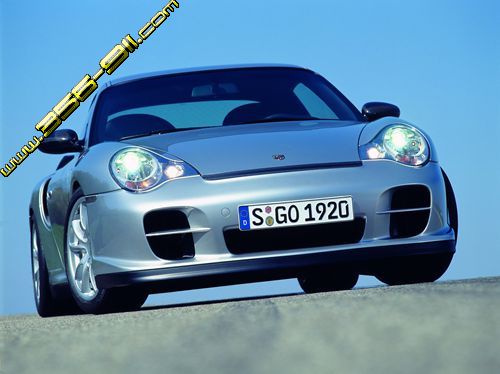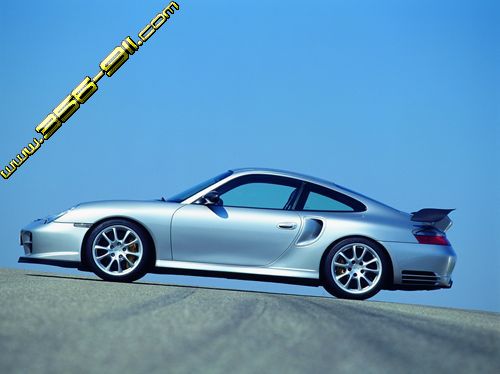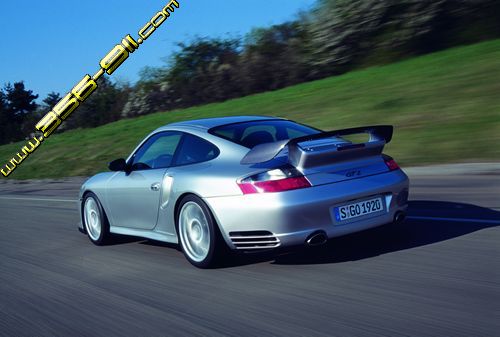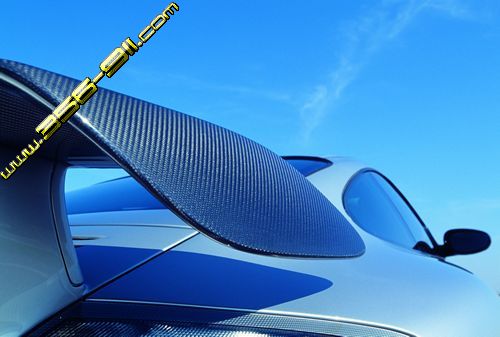Porsche 996 GT2 2004




Porsche 911 GT2
Highlights
Even more power,even faster
The most powerful 911 is now even more dynamic and muscular,the biturbo power unit of the 911 GT2 developing maximum output of 355 kW or 483 bhp at an unchanged 5700 rpm as of the 2004 model year.This is 15 kW or 21 bhp more than before.And at the same time maximum torque is up by 20 Newton-metres to 640 Nm (472 lb-ft)between 3500 and 4500 rpm.The reason for this extra power and torque is careful development of the control maps responsible for electronic engine management,the pistons,piston rings and cylinder liners also being upgraded in the interest of extra strength and stability.
The power unit is the high-performance version of the flat-six carried over from the Porsche 911 Turbo.Redesigned for even higher air throughput,the two turbochargers allow an in- crease in absolute pressure under full load to 2 bar.From the engine,the 911 GT2 transmits its staggering power to the rear wheels via a six-speed manual gearbox.
The fastest member of the 911 model range takes a mere 4.0 seconds to accelerate from 0 - 100 km//h,1/10th of a second less than before.And after 12.5 - previously 12.9 - seconds the speedometer is pointing at 200 km/h or 124 mph.This impressive performance continues all the way to the car's top speed of 319 km/h or 198 mph,making the GT2 another 4 km/h faster than before.Maximum engine speed limited by engine management has been increased from 6760 to 6800 in sixth gear.
Carbon rear wing for a top-flight athlete
The focus in developing the GT2 was clear - to achieve sporting performance of the highest calibre.The first objective,therefore,was not to increase engine output over the 911 Turbo to an even higher level,but rather to reduce the weight of the car.Now,weighing 1440 kg or 3175 lb,the GT2 is exactly 100 kg or 220 lb lighter than the 911 Turbo,offering new ideal weight in every respect,with a power-to-weight ratio of 4.06 kg/kW.
Starting with the 2004 model year,the Clubsport version comes additionally with its aero- dynamically designed rear wing made of carbon-fibre-reinforced plastic.This new carbon wing providing the aerodynamic downforce required at the rear weighs approximately 2.8 kilos less than the former wing and is available as an option also on the road version.This special equipment package also includes exterior mirror housings and the outlet air frames at the rear in carbon look.
Supreme driving dynamics of the highest calibre
In its driving behaviour,the 911 GT2 is designed and conceived for handling of the highest standard.Whether lateral acceleration,load change in bends,or changing lanes at high speeds,this supreme Porsche offers equally supreme agility at all times.The foundation for this outstanding performance is provided by aerodynamics improved once again over the 911 Turbo and a further improvement of the front and rear axle set-up with an even firmer spring/damper system as well as modifications to the suspension.
Ceramic brake discs featured as standard
The 911 GT2 comes as standard with PCCB Porsche Ceramic Composite Brakes.These ceramic brake discs are approximately 50 per cent lighter than metal brake discs of the same size,reducing unsprung masses on the car by approximately 18 kilos.Further benefits are the very fast response of the brakes,supreme stability avoiding any fading excellent re- sponse in the wet,a long service life,and absolutely no corrosion.
Porsche 911 GT2
More Power for the Top Performer
Entering the 2004 model year,the most sporting and fastest 911 is even more powerful and faster than ever before.A combination of supreme streamlining,the extremely dynamic suspension,and engine output now increased to 355 kW (483 bhp)gives the 911 GT2 a level of performance and driving dynamics clearly superior even to the ultra-powerful and fast 911 Turbo.
With its power-to-weight ratio of 4.06 kg/kW,the rear-wheel-drive GT2 now accelerates from 0 - 100 km//h in 4.0 seconds,reaching 200 km/h or 124 mph in a mere 12.5 seconds. Top speed,in turn,is 319 km/h or 198 mph.The reason for this increase in power,torque and,accordingly,performance on the road is even more refined and sophisticated engine management with control maps optimised for maximum performance.And increasing power in this way,the mechanical units and components within the drivetrain have been further enhanced in the interest of greater strength and stability.
Air intake scoops at the front moved further to the outside and specially designed for maxi- mum efficiency clearly reveal the enhanced flow of air through the car.The air outlet directly in front of the luggage compartment lid,in turn,provides a clear sign of aerodynamic re- finement.A further sign of distinction versus the 911 Turbo is the rear wing fitted in an even higher position further to the rear than on the 911 Turbo in the interest of even greater downforces.Through ducts in its two supports,the wing also feeds fresh air to the engine. Air flowing down through the ducts goes into a collector box inside the rear lid,from where it flows directly into the air filter.
Six-cylinder horizontally-opposed power unit with enormous output
The power unit of the 911 GT2 has been specially developed as the high-performance version of the 911 Turbo's flat-six.The two turbochargers provide an even higher throughput of air,allowing an increase in absolute pressure upstream of the throttle butterfly to 2 bar under full load.Intercooler air temperature,in turn,remains unchanged despite the increase Model Year 2004 o 911 GT2 23.in compression,new intercoolers with a higher level of efficiency providing the necessary balance.At the engine's maximum speed of 5700 rpm,boost pressure is now 1.95 bar, reaching its maximum limit at speeds in excess of 6200 rpm.As a result,the driver benefits from consistent power and performance also above maximum engine speed with increasing exhaust gas counter-pressure.
As on the 911 GT3 and the 911 Turbo,oil supply to this high-performance power unit is provided by classic dry sump lubrication with a separate oil tank connected firmly to the engine.With optimum configuration of the oil pumps and in conjunction with the greater volume of the oil tank,this system makes sure that the engine receives a reliable supply of oil both under extreme and long-lasting lateral and longitudinal acceleration,the entire oil circuit accounting for a capacity of approximately 11 litres.
In developing the exhaust gas system,Porsche's engineers have given particular significance to the use of silencers with reduced exhaust gas counter-pressure.Exhaust emissions remain at the same level as with the 911 Turbo,easily fulfilling the strict D4 standards.This,in turn,is equal to the EURO 4 limits under the standard test conditions not even coming into force until 1 January 2005.And it almost goes without saying that the 911 GT2 fulfils the LEV standard in the USA.
911 GT2 with VarioCam Plus
Following the 911 Turbo,the 911 GT2 was the second Porsche to features VarioCam Plus. This valve lift adjustment system upgrading former VarioCam axial camshaft adjustment into VarioCam Plus is made up of two interacting,switching cup tappets on the intake side of the engine operated by two cams on the intake camshaft varying in size.This allows optimisation of power and torque,on the one hand,as well as a reduction of fuel consumption and exhaust emissions,on the other.Engine refinement is also enhanced in the process. 24 Model Year 2004 o 911 GT2.
Available exclusively with six-speed manual gearbox
Power is transmitted to the rear wheels of the 911 GT2 by a six-speed manual gearbox,an improved version of the former model with external transmission fluid cooling and splash oil lubrication.The transmission ratios on the various gears as well as the final drive ratio have been carried over from the 911 Turbo,together with all the improvements to maximise strength and optimise noise control.The synchromesh rings on gears 3 - 5 are made of steel instead of brass,the extra strength of this material serving to meet the greatest demands and requirements.
Uncompromising,sporting chassis and suspension
The chassis and suspension of the GT2 is designed for extra dynamic behaviour and superior handling on the road.Apart from the general demands made of the front and rear axle,this also means that the car's centre of gravity has been lowered by 20 millimetres, further features being adjustable anti-roll bars and a spring system compatible with racing springs,as well as axle geometry offering an even wider range of adjustment.This allows the driver to optimise the set-up of the chassis for superior racing on the track.
New four-channel ABS in conjunction with ceramic brake discs
Ongoing progress in electronics also serves to further enhance the performance of the GT2's brake system:Instead of two-channel version 5.3 ABS used so far,the brake system is now monitored by the new four-channel 5.7 ABS generation already featured in the 911 Turbo and 911 GT3 to prevent the tyres from losing their grip.The benefits of this four-channel sy- stem are even faster and more sensitive response in controlling the ABS function.And since all four wheels are controlled individually,particularly the stability of the car,its initial brake application behaviour and,accordingly,brake stability in bends are improved significantly.
The GT2 is Porsche's first sports car fitted as standard with PCCB Porsche Ceramic Com- posite Brakes.Measuring 350 millimetres or 13.78"in diameter,these cross-drilled and inner-vented composite ceramic brake discs weigh 50 per cent less than metal discs,re- ducing unsprung masses by approximately 18 kg or almost 40 lb.In conjunction with the Model Year 2004 o 911 GT2 25.specially matched brake lining,ceramic brake discs immediately build up a very high and, in particular,consistent frictional coefficient during deceleration.Abrasion,in turn,is kept to an absolute minimum versus metal brake discs,thanks to the extreme surface hardness of these ceramic units.Service life of the ceramic brake discs under normal driving con- ditions is increased accordingly,a further advantage being that this material is absolutely free of corrosion,ceramic brake discs not even responding to solid or liquid salt on the road.
Looks and equipment
From outside the new version of Porsche's top-of-the-range sports car can only be distin- guished through various details taking a trained eye to discover:The 911 GT2 comes on new wheels in GT3 design measuring 8 1 /2 "across at the front and 12"at the rear - and,, in all,reducing weight by another 1.8 kilos versus the former rims.The 18-inch light-alloy wheels come with 235/40 ZR 18 tyres featured as standard at the front,with 315/30 ZR 18 tyres at the rear.The wheel hub cap,in turn,proudly displays a discreet GT2 logo.
Inside the GT2 leather-covered bucket seats made of a special synthetic material replace the usual seats so well-known on the 911,guaranteeing not only optimum side support,but also excellent comfort on long distances.As an alternative the 911 GT2 comes as a no-cost option with slightly comfort-oriented sports seats also adjustable for height and available as an option with seat heating.Other standard features naturally include driver,front passenger and side airbags,as well as electric window lifts,an electronic immobiliser with a transponder, central locking with remote control,and an alarm system.
Other no-cost options on the GT2 are the CDR 23 CD radio as well as automatic air con- ditioning including an activated carbon filter.Further options also available are PCM Porsche Communication Management and a CD changer.The PCM equipment package includes a double-tuner,a CD player,dynamic route navigation,a trip computer and,as an option,a DSM dual-band telephone.
Clubsport version with carbon rear wing
The 911 GT2 is also available in Clubsport trim standing out in particular through the use of carbon components.The exterior mirrors as well as the air extraction frame at the rear, for example,are hand-made from carbon-fibre-reinforced plastic.The rear wing is made completely of carbon and is approximately 2.8 kilos or 6.2 lb lighter than the standard wing on the GT2.These carbon components are incidentally also available as an option on the GT2 in regular road trim. Another special sign of distinction on the Clubsport version is the rollbar bolted on to the body of the car and extending if required into a genuine roll cage.The seats also differ from the standard versions,being finished in flame-retarding fabric instead of leather.The philo- sophy underlying the development of these Clubsport features is their simple and straight- forward homologation for participating in official motorsport events without any particular trouble or complicated modifications.
